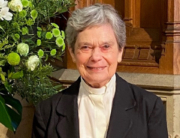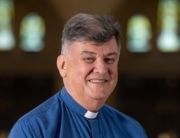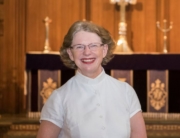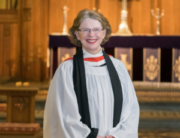Preacher: The Rev’d Jenny Wilson
In the name of God, creating, redeeming, sanctifying, … Amen.
This evening, at Choral Evensong, we find ourselves in a Cathedral that is not only awash with word and music but also art. We have gathered earlier this day, regular worshippers in this cathedral and visitors, to hear the patron of our Cathedral Art Exhibition, and indeed its founder, Michael Neale, reflecting on art and spirituality in his annual talk. And so, my theme, this evening, too is art, and how art might help us to reflect, even to pray. When we enter a sacred space like this one, we enter in the midst of ordinary life. It may be that we are living in a time of joy. It may be that we are living in a time of hardship. It may be that political events in our country or in countries across the world leave us profoundly worried, even ashamed. It may be that the sufferings of those caught up in the many natural disasters that seem to be playing out across the planet are on our hearts. Those in these situations are strangers to us and yet we sense their common humanity, sense that “there but for the grace of God go we” as the saying goes. We may enter this cathedral simply wishing to give thanks for the gift of life and those who are dear to us.
Whatever, our thoughts, our preoccupations, when we enter a sacred space like this one, we may find that we are given a window – a window into the nature of God and a window into the nature of human beings. All scripture does this – speaks of God, speaks of human-, and indeed all created-, nature. And so in all music, such as the chanting of Psalm 23 that we heard tonight, or the setting by William Byrd of the Canticles, the Magnificat and the Nunc Dimmittis, all written and spoken reflections, all architecture and indeed all art, that we experience in this place, we might be given a glimpse, some insight, a new thought, perhaps, about who God is and who we are. We might be given some insight into ourselves, ones made in the image of God, loved dearly by God, and yet with a tendency to a great flawedness, to sin, to “failing to let God be God” as one spiritual writer put it, trying to describe our brokenness. We might be able to make our confession, to find a way to speak of what we regret. We might be able to pray.
How might art help us? What insight does art give? In what way can the presence of a painting nurture prayer?
The theologian, John Drury, found himself one Christmas struggling with his sermon for the community of Christ Church, Oxford, where he was the Dean. He wrote, “Preparing a sermon for the fourth time round, I was depressed by the all-too-familiar, all-too-doctrinal assertions that got onto paper. They did not look like much of a present for people enjoying a popular and cherished festival.” Struggling in this way with trying to find something to say about God, about what it is to be a human to those who like us have walked in in the midst of ordinary life, if on Christmas Day, John Drury remembered a painting. He continues …”Vivid memories of Poussin’s [ painting] The Adoration of the Shepherds in the National Gallery suggested a different kind of sermon. Postcards of this picture were put into people’s hands as they came into the cathedral and the sermon consisted in an analysis of its structure and contents …” (pxiii) Inspired by this experience, John Drury went on to write a book, Painting the Word, about Christian paintings and how they convey their messages. In the second chapter of his book, a chapter which he has entitled “Kind Regards”, John Drury discusses several paintings whose subject is looking, gazing. What he says, I think might help us as we gather in our cathedral at the time of the Art Show, at a time when we might wonder how art nurtures our reflection, our prayer.
One painting that he discusses is that of a family, The Vendramin Family, by Titian. This painting has three generations of a family – children, men in middle age and a old man gazing at a cross on an alter. We learn much from John Drury’s words about the way we look, the way we love, at different times in our lives – he notices in Titian’s painting that the children are distracted, that those in middle age are looking intensely at the cross, and that in the one who is old there is the gentle wise look of one “who has made his life, has settled his account with God”, who looks outward at others. What I love most about what John Drury says about this painting, The Vendramin Family, is this: “Love is active among them, love of God and love of neighbour … it’s chief mode is looking.” (p29)
“Love is active among them, love of God and love of neighbour … it’s chief mode is looking.”
For is this is what we are talking about this evening, in a cathedral surrounded with art. What do we do with a painting but look, gaze, give it our attention. Allow it to move us. What are we talking about but prayer whose chief mode is looking …Loving God, by looking ….Allowing ourselves to be transformed by looking …
A second painting on which John Drury reflects is by Duccio – it is a The Virgin and Child with Saints. This painting is a triptych, a painting in three parts, that closes like a book. In the central panel we find a classic virgin and child painting in which the child Jesus lifts a veil to gaze at his mother Mary’s face. John Drury writes:
“By putting the unveiling of the face at the centre of his [painting], Duccio … makes a connection between the focal point of Christian heaven and the primal source of individual well-being. And we have a clue to the conundrum of why it is that looking and being recognised can be such a source of profound happiness. … Ordinary physical looking is a primary form of grace…” (p36)
Ordinary physical looking is a primary form of grace …
And so here we are in our cathedral at the time of its annual Art Prize exhibition. In the presence of paintings inviting us to spend a little time looking. That looking that is a primary mode of grace. When I enter a gallery what I most like to do is find one or two paintings with which I might spend some time – paintings that invite me somehow. And hopefully a chair or a bench on which to sit. And then simply give the one or two paintings my attention, my time, my gaze. Allowing the paintings to change me if you like.
May we, this evening, and through the course of this week, spend a little time with a painting or two, or a stained glass window, or part of the architecture of this beautiful cathedral that we are fortunate to call our spiritual home, may we offer the painting out time, may we allow it to bless us, may we know a little of John Drury’s insight that ordinary physical looking is a primary form of grace.




